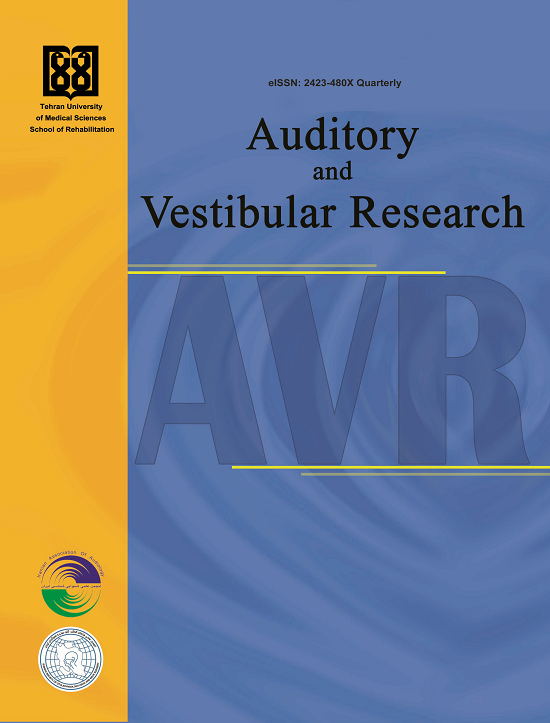The Validity and Reliability of the Speech Prosody Comprehension Test for Children with Normal Hearing and Cochlear Implants
Abstract
Background and Aim: The comprehension of speech prosody, the nonlinguistic elements of speech that convey emotions, is crucial for social interactions and speech comprehension. This study aimed to investigate the validity and reliability of the Speech Prosody Comprehension Test (SPCT) for Persian-speaking children aged 7–10.
Methods: In this study, face validity, construct validity, discriminant validity, testretest reliability by calculating the Intraclass Correlation Coefficient (ICC), and internal consistency using Cronbach’s alpha coefficient of the SPCT were examined on 32 children aged 7–10 years, including 22 with normal hearing (mean age=8.63±1.04 years) and 10 with unilateral Cochlear Implant (CI) (mean age=9.20±0.78 years)
Results: The result demonstrated good face validity (face validity index=88.75). Construct validity was confirmed due to the existence of strong correlations within the subscale items and between the subscale items and the total score. A significant difference in mean scores was found between the normal-hearing and CI groups (p<0.001), indicating discriminant validity. High test-retest reliability was demonstrated for the overall scale (ICC=0.99) and for all subscales (ICC=0.91–0.97). The test also had high internal consistency, with a Cronbach’s alpha of 0.89 for the overall scale.
Conclusion: The SPCT is a valid and reliable clinical tool for assessing speech prosody comprehension in children aged 7–10 with normal hearing and unilateral CI. Further research with larger samples is recommended to confirm the generalizability of the findings to children with other hearing conditions and age groups.
2. Grandjean D. Brain Networks of Emotional Prosody Processing. Emot Rev. 2021;13(1):34-43. [DOI:10.1177/1754073919898522]
3. Ben-David BM, Multani N, Shakuf V, Rudzicz F, van Lieshout PH. Prosody and Semantics Are Separate but Not Separable Channels in the Perception of Emotional Speech: Test for Rating of Emotions in Speech. J Speech Lang Hear Res. 2016;59(1):72-89. [DOI:10.1044/2015_JSLHR-H-14-0323]
4. Erickson D. Expressive speech: Production, perception and application to speech synthesis. Acoust Sci Technol. 2005;26(4):317-25. [DOI:10.1250/ast.26.317]
5. Everhardt MK, Sarampalis A, Coler M, Başkent D, Lowie W. Meta-Analysis on the Identification of Linguistic and Emotional Prosody in Cochlear Implant Users and Vocoder Simulations. Ear Hear. 2020;41(5):1092-102. [DOI:10.1097/AUD.0000000000000863]
6. Taitelbaum-Swead R, Icht M, Ben-David BM. More Than Words: the Relative Roles of Prosody and Semantics in the Perception of Emotions in Spoken Language by Postlingual Cochlear Implant Users. Ear Hear. 2022;43(4):1378-89. [DOI:10.1097/AUD.0000000000001199]
7. Kulkarni AM, Combs J; Fitzpatrick D, Chatterjee M. Utilization of acoustic cues to identify emotional prosody: Results in adults with normal hearing or cochlear implants. J Acoust Soc Am. 2023;153(3 Suppl):A48. [DOI:10.1121/10.0018113]
8. Pak CL, Katz WF. Recognition of emotional prosody by Mandarin-speaking adults with cochlear implants. J Acoust Soc Am. 2019;146(2):EL165. [DOI:10.1121/1.5122192]
9. Yeshoda K, Raveendran R, Konadath S. Perception of vocal emotional prosody in children with hearing impairment. Int J Pediatr Otorhinolaryngol. 2020;137:110252. [DOI:10.1016/j.ijporl.2020.110252]
10. Maner-Idrissi GL, Bissaoui SLS, Dardier V, Codet M, Botte-Bonneton N, Delahaye F, et al. Emotional Speech Comprehension in Deaf Children with Cochlear Implant. Psychol Lang Commun. 2020;24(1):44-69.
11. van den Broek EL. Emotional Prosody Measurement (EPM): a voice-based evaluation method for psychological therapy effectiveness. Stud Health Technol Inform. 2004;103:118-25. [DOI:10.3233/978-1-60750-946-2-118]
Torke Ladani N, Agharasouli Z, Ashayeri H, Mahmoudi Bakhtiyari B, Kamali M, Ziatabar Ahmadi SZ. [Development, validity and reliability of the speech prosody comprehension test]. Audiol. 2012;21(1):69-75. Persian.
13. Cutler A, Dahan D, van Donselaar W. Prosody in the comprehension of spoken language: a literature review. Lang Speech. 1997;40( Pt 2):141-201. [DOI:10.1177/002383099704000203]
14. Fleiss JL, Levin B, Paik MC. Statistical Methods for Rates and Proportions. Wiley; 2003. [DOI:10.1002/0471445428]
15. Terwee CB, Bot SDM, de Boer MR, van der Windt DAWM, Knol DL, Dekker J, et al. Quality criteria were proposed for measurement properties of health status questionnaires. J Clin Epidemiol. 2007;60(1):34–42. [DOI: 10.1016/J.JCLINEPI.2006.03.012]
16. Kao C, Zhang Y. The development of emotional speech prosody perception in 3- to 14-month infants: a preferential listening study. J Acoust Soc Am. 2019;145(3 Suppl):1764. [DOI:10.1121/1.5101459]
17. Myers BR, Lense MD, Gordon RL. Pushing the Envelope: Developments in Neural Entrainment to Speech and the Biological Underpinnings of Prosody Perception. Brain Sci. 2019;9(3):70. [DOI:10.3390/brainsci9030070]
18. Hawthorne K, Mazuka R, Gerken L. The acoustic salience of prosody trumps infants’ acquired knowledge of language-specific prosodic patterns. J Mem Lang. 2015;82:105-17. [DOI:10.1016/j.jml.2015.03.005]
19. Pronina M, Hübscher I, Vilà-Giménez I, Prieto P. Pragmatic prosody development from 3 to 8 years of age: A cross-sectional study in Catalan. In: Speech Prosody 2022. ISCA: ISCA; 2022. p. 92-6. [DOI:10.21437/speechprosody.2022-19]
20. Veenendaal NJ, Groen MA, Verhoeven L. The role of speech prosody and text reading prosody in children’s reading comprehension. Br J Educ Psychol. 2014;84(Pt 4):521-36. [DOI:10.1111/bjep.12036]
| Files | ||
| Issue | Vol 34 No 4 (2025) | |
| Section | Research Article(s) | |
| DOI | https://doi.org/10.18502/avr.v34i4.19953 | |
| Keywords | ||
| Speech prosody comprehension test children validity reliability cochlear implant speech prosody | ||
| Rights and permissions | |

|
This work is licensed under a Creative Commons Attribution-NonCommercial 4.0 International License. |






